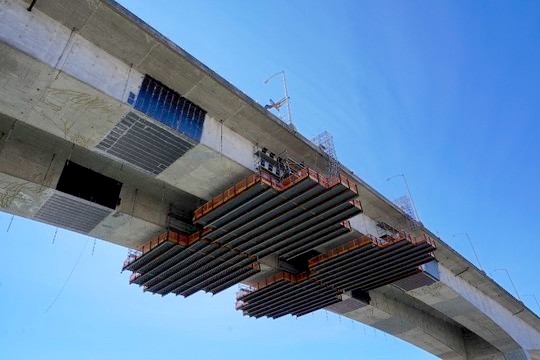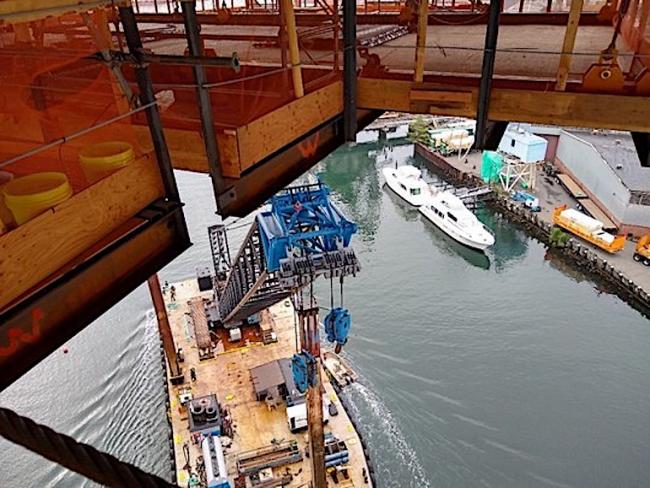SDOT update on West Seattle Bridge initial repairs and stabilization
View from above: A crane barge passes beneath the work platform suspended from the West Seattle High-Rise Bridge.
photo courtesy of SDOT
Fri, 10/02/2020
The Seattle Department of Transportation has offered their weekly update on progress being made on the West Seattle Bridge initial repairs as we await their decision to execute either more complete repairs or plan for demolition.
High-Rise Bridge Stabilization
Kraemer North America, our contractor for the stabilization work, is working every week, Monday through Saturday from 6 AM to 4:30 PM, to stabilize the bridge. This Sunday, October 4, they will be working during these same hours, from 6 AM to 4:30 PM.
Stabilizing the High-Rise Bridge is necessary to preserve public safety and the integrity of the bridge so all options remain on the table for a repair or replace decision. Stabilization puts us on the right path if repair is determined to be the best option. If we move forward with replacement, stabilization ensures no further damage is done and that the public is kept safe during design and construction of the replacement.
The stabilization work is expected to continue for the next several months and includes carbon fiber wrapping weakened areas of the bridge, adding post-tensioning inside the girders, and injecting epoxy into cracks that are wider than 0.3mm. The epoxy injections don’t stabilize the bridge; they help prevent further deterioration by protecting the post-tensioning steel inside from corrosion.
This coming week, the contractor is planning to:
- Install the post-tensioning system
- Prep for Pier 18 release; the release could happen as soon as the week of October 19
During daily work, you will see some crews working on top and under the bridge. You will also see scaffolding and crews working on platforms suspended under the bridge. You may also see large equipment and vehicles delivering, moving, and storing materials.
There is also work taking place inside the bridge that you will not be able to see. That work includes monitoring cracks and installing the additional post-tensioning strands. We do not anticipate any additional traffic impacts from this work over the next few weeks.
While we do not anticipate significant impacts to traffic below the bridge, you may see some traffic control signs and devices. These signs and devices are meant to keep the workers and traveling public safe. Please obey the signs and do not move them.

Upcoming Work
Over the next few weeks, the contractor will continue stabilization work listed above and will also work to “release” the restrained bearing at Pier 18. We could be doing the Pier 18 “release” as soon as the week of October 19. Leading up to the Pier 18 “release”, the contractor will be installing a post-tensioning system inside the girder.
While the majority of the traveling public will see little to no traffic impacts during Pier 18 work, there may be lane reductions on Klickitat Ave SW and SW Klickitat Way on the west and south sides of Harbor Island. Please obey the traffic control signs and devices and do not attempt to move them.
Our teams are coordinating closely with the Port of Seattle to mitigate traffic impacts.
Other stabilization work will include applying additional layers of CFRP to the girders after the Pier 18 release and post-tensioning are complete. Once all stabilization work has been finished, we will lower the work platforms onto barges. This will likely be in late November.
In the coming weeks, we will make the final determination as to whether we will move forward with repairing the current bridge or replacing it with a new structure. With our replacement consultant HNTB on board, we are ready to pivot to designing the demolition and replacement structure, should it be determined that it’s in the public’s best interest to replace rather than repair.
Past Work
Since SDOT closed the bridge in March, we have:
- Installed intelligent monitoring system to better understand what type of stabilization and repairs would be needed and to monitor the bridge during this work.
- Designed and started to install stabilization measures.
- Built and hoisted custom work platforms.
- Completed the first phase of carbon fiber wrapping.
- Started the cost-benefit analysis (CBA) that will help inform the decision to repair or replace the bridge.


